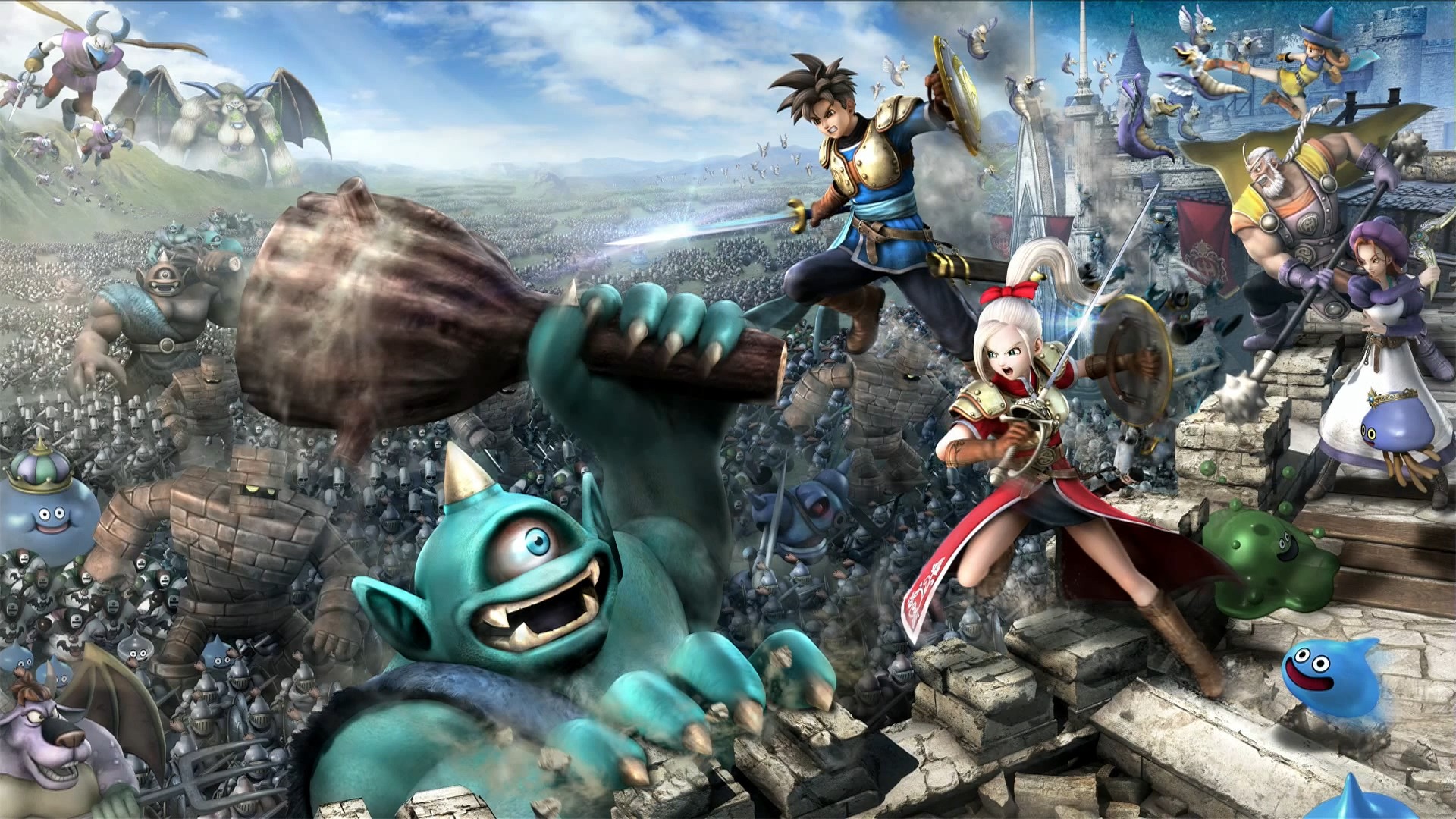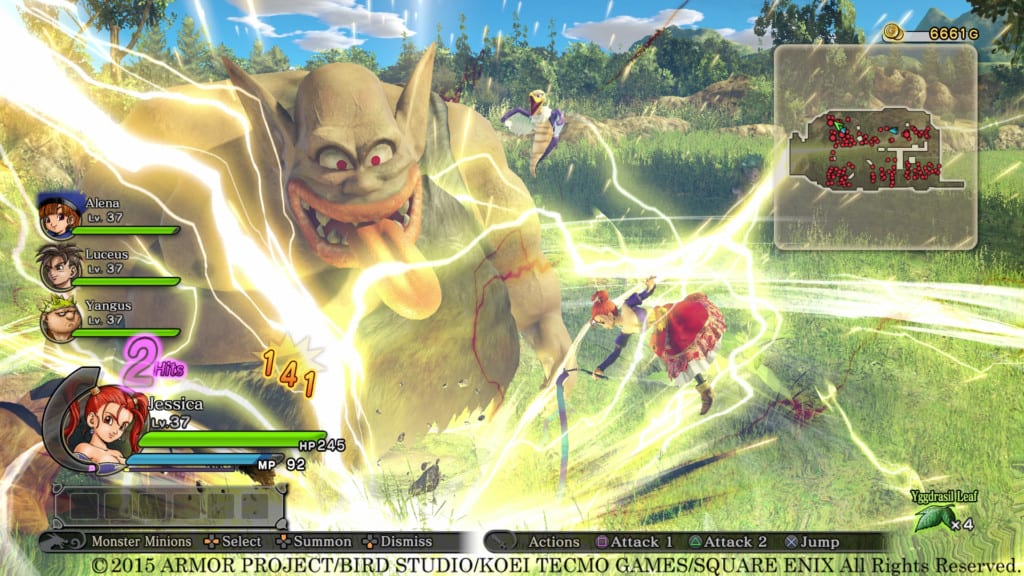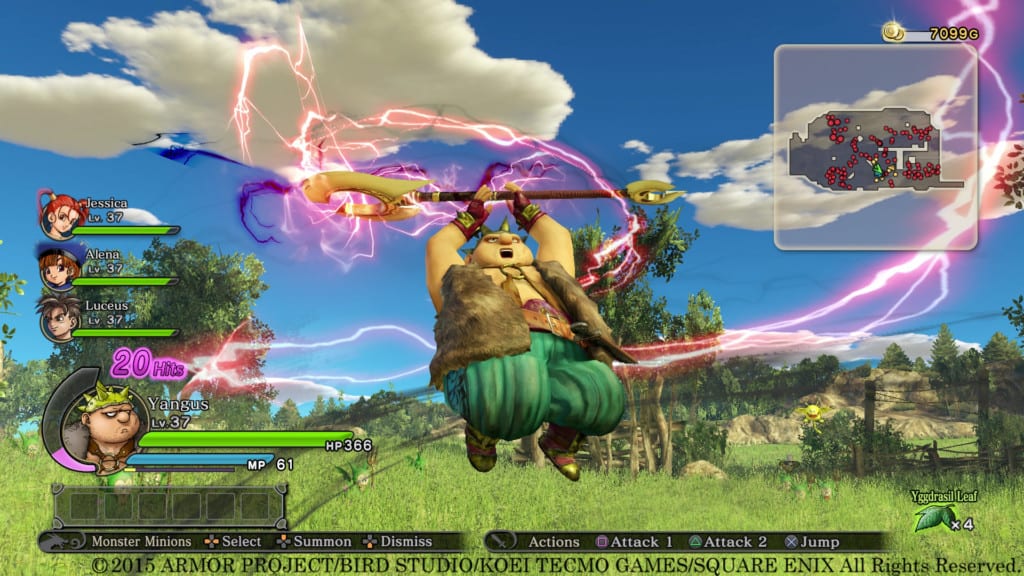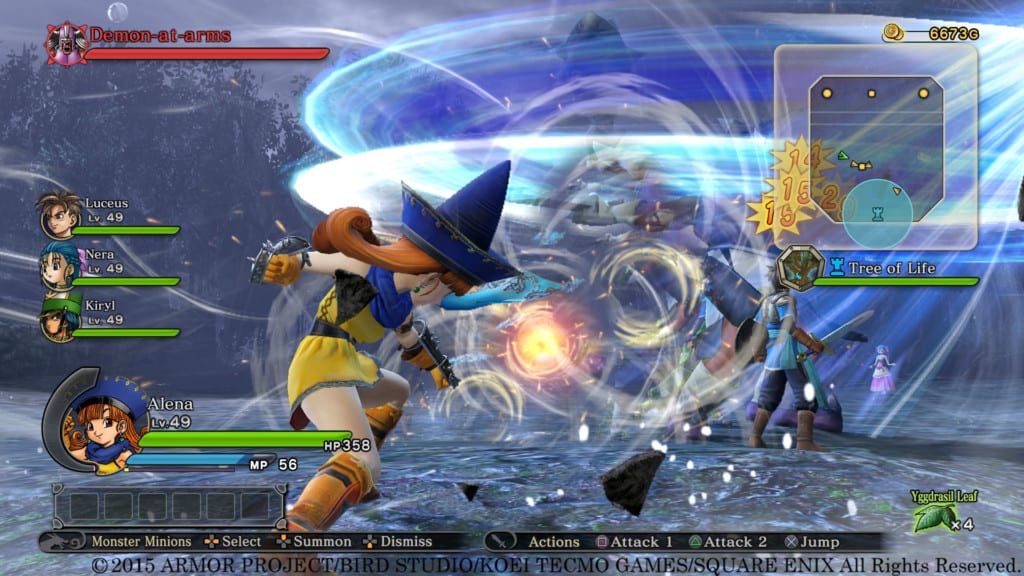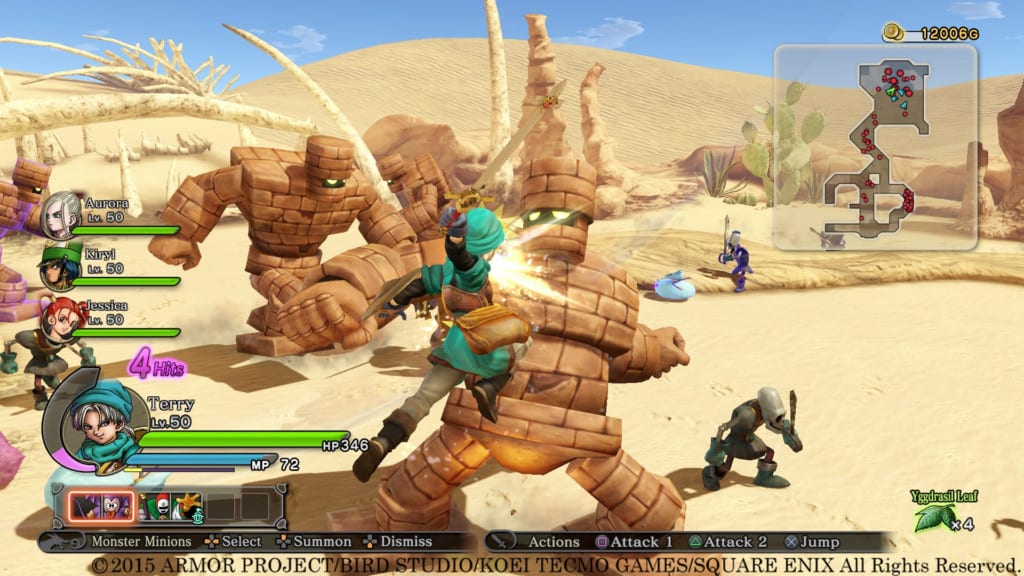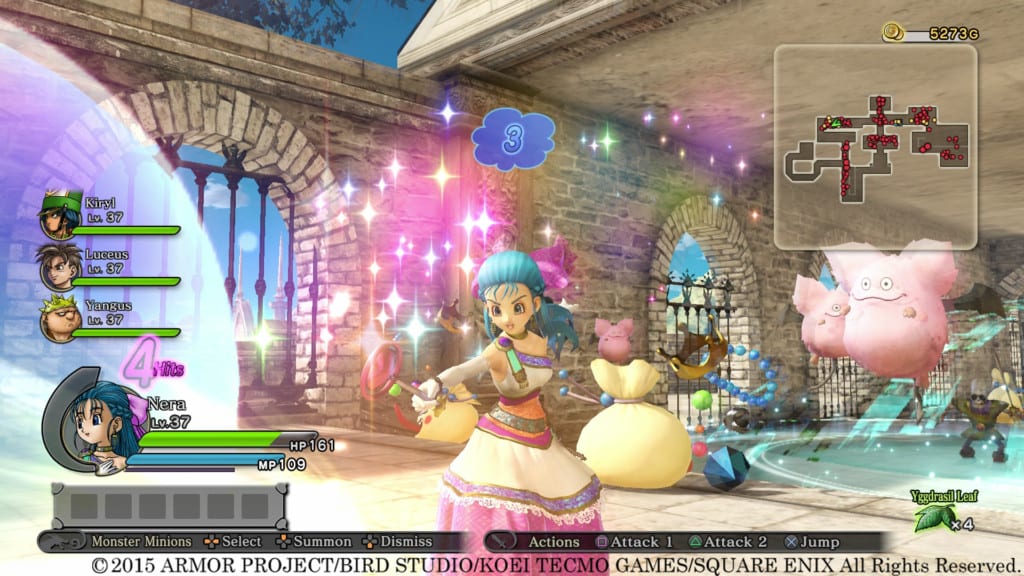Title – Dragon Quest Heroes
Platforms – PS4, PS3, PC, Nintendo Switch
Release Date – February 26th, 2015
Developer – Omega Force
Publisher – Square Enix
MSRP – $59.99
ESRB – T for Teen
Disclaimer – This product is being reviewed on the PlayStation 4. A review copy was provided by the Gaming Instincts staff for the purpose of this review. This review may also contain spoilers for certain gameplay and story elements. Watch at your own risk, you have been warned. Gaming Instincts is an Amazon Affiliate and does gain financial benefits if you choose to purchase this product on this page.
Introduction
Dragon Quest Heroes is a spinoff Action-RPG/Musou title that’s based on the popular Dragon Quest RPG series. It’s the first time in the history of the franchise where the developers decided to create gameplay that’s outside their comfort zone, while keeping familiar characters, enemies, and environments that fans all know and love. Another popular franchise that took the same route was Zelda: Hyrule Warriors, which was rather successful and considered one of the best Musou games out there.
Story
The plot in Dragon Quest Heroes is simple and easy to understand—the cute and cuddly monsters have turned against the humans. Players are on a quest to figure out why the creatures became evil and started to assault every possible town. As players go through the game, they will be meeting many different characters with unique personalities; these characters will also join users’ party. The player will visit different locations throughout the world map and save towns from being overwhelmed by the monsters. If fans are looking for an epic RPG plot, they’re not going to find it here because that is not what this game is trying to accomlish. Dragon Quest was always known to have semi-serious stories with humorous dialogue, cutesy monsters such as the slime kings, brownies, goofy-looking dragons, along with many other silly aspects. The art style of the game should also be familiar to fans. Akira Toriyama’s influence is apparent not just in the art style, but also in his sense of humor in the writing. The game delivers what fans would expect from the franchise in terms of silliness, aesthetics, heroes, and enemies.
Visuals and Audio
The game’s visuals are clean and colorful, as one would expect from a typical Dragon Quest title, but ten times prettier this time around. However, while the art style is well-done, the technical side has some minor faults. The game runs at 60 FPS and 1080p HD, but the problem is there have been noticeable times when the frame-rate drops for a split-second, or maybe even a full second. It doesn’t hamper the gameplay and the fast-paced combat by any means, thankfully. However, the fact the game still hiccups here and there, despite how plain the levels are, is a bit disappointing. Regardless, it’s not that big of a surprise considering there are a ton of mobs on the screen and flashy special combos. The game also tends to drop frames when players turn their camera left or right both in main missions and town hubs where there are no enemies. Overall, the technical issues are not that problematic.
The audio in the game is basic. There are different music themes for each of the levels, battles, level-up cues, funny monster sounds, and Japanese and English voice-overs. Those who have played a Dragon Quest game before know what to expect. As always, players will hear many similar sound cues that are nostalgic. However, the game repeated the same music theme too many times, crossing the line into overly repetitive. Overall, the audio is not necessarily bad; however, if there were a larger variety of tracks, the music would have been more enjoyable, though, it’s not that big of an issue.
Combat System, RPG Elements, and Gameplay
The gameplay is comprised of typical RPG elements such as crafting, inventory space, items, accessories, weapons, NPCs, town hubs, talent trees, party system, and leveling. Mix all of those RPG elements with hack ‘n’ slash Musou style gameplay, such as the Dynasty Warrior games and Zelda: Hyrule Warriors, and fans get Dragon Quest Heroes.
The combat system is similar to other Musou games. Players have their basic combo attacks, a particular gauge called ‘tension’, and special attacks that use a mana bar. The ‘tension’ bar builds up as gamers hit enemies. Once the bar is full, one can activate Tension Mode. While in Tension Mode, characters do more damage than normal, have invincibility for a limited time, and execute a signature “coup de grace” move on the battlefield.
During combat, the player can also collect monster medals after they defeat an enemy. Monster medals have a chance of dropping, but once a player picks them up, it starts to fill up the monster slot bar. These medals allow players to summon minions on the battlefield to aid them. Dragon Quest Heroes has a large variety of different monsters ranging in many different shapes and sizes. Small monsters take up one slot, medium sized monsters take up two slots, and big ones take up three slots. For example, a skeleton soldier would only take up one slot, while a golem or troll would take up three slots. Once gamers are full of medals, they can start to dismiss the ones they don’t need if they want to pick up better ones. It’s worth stating that some monsters will only do one-time moves and disappear, while others will stay and fight until their health bar depletes. The monster medals are an interesting take on strategic gameplay, but they aren’t needed much to get through the game unless in a dire situation. However, it was fun to watch a big troll monster fighting against a wave of skeletons.
The party system in the game allows fans to have three other party members with them; they can switch to whatever party member they want in the middle of the battlefield. As players progress through the story, they will have party members join them. Throughout one’s journey in Dragon Quest Heroes, they will end up playing up to 12 unique, playable characters including Leceus, Aurora, Doric, Terry, Isla, Nera, Bianca, Yangus, Alena, Kiryl, Jessica, and Maya. Each of these unique individuals use their signature weapons and serve a particular role in battle. For example, Yangus is superb at taking down the enemy’s defense with his special overhead attack, and he can absorb a ton of damage. Meanwhile, a character like Jessica can hit multiple enemies with her whip, and can heal the entire party by doing a dance move. Then there are characters like Aurora, Luceus, and Terry, who all use swords and shields, but have different elements imbued in their weapons, such as ice, fire, and thunder. Isla uses a boomerang for long distance combat, and Doric has his trusty mace that lets him slay his foes in a wide arc, with multiple elements, and more.
The heroes themselves are likable, have intriguing personalities, and are funny. The AI is surprisingly well-done, despite its flaws. Allies will heal players and the party when necessary if they have the mana. However, there are times when they just stand still, doing nothing, being useless for a few seconds. For the most part, the AI is decent despite a few inconsistencies here and there. Compared to other Musou games, it’s a godsend.
The mission and story structure are super simple. Players go to each city via ‘World Map’, complete a few missions, and fight a boss, then move on to the next area and rinse and repeat. The game doesn’t have any open-world exploration. Instead, players are in a city hub where they can talk to multiple NPCs that let them buy weapons, orbs, craft accessories, take on quests, save progress, read in-game mail, and prepare themselves for the next mission. During gamers’ journey, they will go through varied environments such as grasslands, deserts, caves, dungeons, and castles. The actual maps themselves are small. There is a mini-map on the top right, and during fans’ objective, they can explore the map to collect treasures that contain mini-medals, gold, or ingredients. They can also break barrels, pots, and other kinds of breakable objects around them for instant health and mana restoration items.
The primary mission objectives tend to repeat themselves throughout the game. They range from defense to annihilating all monster waves while trying to slay all of the Mawkeepers. Mawkeepers are creatures who call upon more minions from their realm into the battlefield. Dragon Quest: Heroes tries to cover the repetition of this in different ways, and the defense is a perfect example of that. In one mission, players are attempting to protect a magical tree root called Yggdrasil, while in another mission, they’re defending a generator, an ally, statue, or a door. It doesn’t change the gameplay in any fashion. Instead, it repeats itself with a new excuse and tells fans to keep slaying a massive amount of monsters until they’re all gone and players have successfully defended the object. Given this is a Musou game, however, that isn’t surprising. There isn’t much one can do in terms of gameplay variety when the core of the genre is to keep killing a tremendous amount of monsters and grind for power, ingredients, and levels.
The RPG elements are apparent; players level up each of their party members, and each hero has a talent tree. The talent trees of each character, however, are similar. For example, every hero has basic things they can upgrade, such as their mana/health pool, defense, and magical powers. They do offer some unique features, such as their special attack upgrades, but for the most part, they’re all similar. As gamers level up, it will cost them more allocation points to spec into something, and if they made a mistake, they can undo their choices by talking to an NPC in the town hub to reset the talents for a certain amount of gold.
Heroes will also be able to take on quests from an NPC, and the quests are an important part of character progression. When players complete certain quests, they will get rewarded with more bag space for their crafting ingredients, more monster medals slots, and mini-medals that can be used as currency to get new recipes for crafting. The crafting system is easy to use. Players collect items from monsters as they kill them, and certain monsters drop certain ingredients. Once users have the proper ingredients, they can then talk to the alchemist NPC in the town hub and craft accessories. They can also make the same accessory more powerful by crafting multiple accessories at a time, and sacrificing them to give it more power; this mechanic is called “Meld Accessories.” Jewelry provides different boosts to their characters, such as defense, more attack power, or even minion boosts. Each character can equip up to three different accessories at a time, and it’s going to cost players a pretty penny if they want to deck everyone one out in the best possible items. There are also weapons and orb merchants that sell equipment for heroes. Starting off, the weapons and orbs are cheap; however, later in the game, everything becomes super expensive, and when there are 12 heroes to consider, it can get overwhelming—but in a good way. Orbs are special items that increase a hero’s overall main defense stats. The more expensive orbs also provide more bonuses to other defensive attributes. Dragon Quest: Heroes does decent job at implementing RPG elements into the Musou genre.
Thankfully, the RPG elements are what make this game fun and addicting. By the time one finishes the game, they will still have a large amount of stuff to do, such as collecting all the accolades for completing certain in-game objectives. Accolades can be acquired by killing the main bosses, keeping up a high hit count, and using every character’s “coup de grace”, buying every single weapon, orb, and shield in the game, and plenty of other activities. To gather every accolade, it will take one at least 50-70 hours of gameplay, which is a healthy amount of time playing, especially for perfectionists. Also, the game makes it super easy to keep track of what players have and haven’t collected by going to the main menu and checking out the Battle Log. The Battle Log shows progression in terms of percentage for monsters, minions, weapons/orbs, ingredients, accessories, and quests. This makes hunting for everything in the game more enjoyable because players don’t have to worry about writing a checklist.
Final Verdict
Dragon Quest: Heroes is a fantastic spin-off with a lovable cast of characters, hilarious monsters, beautiful cartoon visuals, and addicting gameplay. However, the game does have some minor technical flaws, such as FPS issues, despite it being consistent 90% of the time. The mission objectives can get a bit tiresome by the time one finishes the game, but solid, basic gameplay is fun enough to finish the title and even continue post-game to collect everything 100%. The main story lasts for a good while; probably for 20 hours or more depending on how good one is at understanding the combat mechanics, and whether or not players are rushing through it. Post-game content will take roughly 50-70 hours, especially for trophy hunters.



